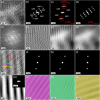Considerable knock-on displacement of metal atoms under a low energy electron beam
- PMID: 28298631
- PMCID: PMC5428036
- DOI: 10.1038/s41598-017-00251-3
Considerable knock-on displacement of metal atoms under a low energy electron beam
Abstract
Under electron beam irradiation, knock-on atomic displacement is commonly thought to occur only when the incident electron energy is above the incident-energy threshold of the material in question. However, we report that when exposed to intense electrons at room temperature at a low incident energy of 30 keV, which is far below the theoretically predicted incident-energy threshold of zirconium, Zircaloy-4 (Zr-1.50Sn-0.25Fe-0.15Cr (wt.%)) surfaces can undergo considerable displacement damage. We demonstrate that electron beam irradiation of the bulk Zircaloy-4 surface resulted in a striking radiation effect that nanoscale precipitates within the surface layer gradually emerged and became clearly visible with increasing the irradiation time. Our transmission electron microscope (TEM) observations further reveal that electron beam irradiation of the thin-film Zircaly-4 surface caused the sputtering of surface α-Zr atoms, the nanoscale atomic restructuring in the α-Zr matrix, and the amorphization of precipitates. These results are the first direct evidences suggesting that displacement of metal atoms can be induced by a low incident electron energy below threshold. The presented way to irradiate may be extended to other materials aiming at producing appealing properties for applications in fields of nanotechnology, surface technology, and others.
Conflict of interest statement
The authors declare that they have no competing interests.
Figures





Similar articles
-
Beam-induced motion of adatoms in the transmission electron microscope.Microsc Microanal. 2013 Apr;19(2):479-86. doi: 10.1017/S1431927612014274. Epub 2013 Feb 21. Microsc Microanal. 2013. PMID: 23425385
-
Effect of electron beam irradiation in TEM on the microstructure and composition of nanoprecipitates in Al-Mg-Si alloys.Micron. 2019 Jan;116:116-123. doi: 10.1016/j.micron.2018.10.003. Epub 2018 Oct 9. Micron. 2019. PMID: 30368200
-
In situ disordering of monoclinic titanium monoxide Ti5O5 studied by transmission electron microscope TEM.Sci Rep. 2017 Sep 7;7(1):10769. doi: 10.1038/s41598-017-11164-6. Sci Rep. 2017. PMID: 28883549 Free PMC article.
-
Electron irradiation effects in transmission electron microscopy: Random displacements and collective migrations.Micron. 2023 Aug;171:103482. doi: 10.1016/j.micron.2023.103482. Epub 2023 May 4. Micron. 2023. PMID: 37167653 Review.
-
LEEM investigations of surfaces using a beam of energetic self-ions.Microsc Res Tech. 2009 Mar;72(3):197-207. doi: 10.1002/jemt.20672. Microsc Res Tech. 2009. PMID: 19170160 Review.
Cited by
-
Modifications of Polymeric Membranes Used in Guided Tissue and Bone Regeneration.Polymers (Basel). 2019 May 2;11(5):782. doi: 10.3390/polym11050782. Polymers (Basel). 2019. PMID: 31052482 Free PMC article. Review.
-
Laser-equipped gas reaction chamber for probing environmentally sensitive materials at near atomic scale.PLoS One. 2022 Feb 9;17(2):e0262543. doi: 10.1371/journal.pone.0262543. eCollection 2022. PLoS One. 2022. PMID: 35139091 Free PMC article.
-
Cryo-electron tomography related radiation-damage parameters for individual-molecule 3D structure determination.Front Chem. 2022 Aug 30;10:889203. doi: 10.3389/fchem.2022.889203. eCollection 2022. Front Chem. 2022. PMID: 36110139 Free PMC article. Review.
References
-
- Was, G. S. Fundamentals of radiation materials science: metals and alloys (Springer, New York, 2007).
-
- Murty, K. L., Charit, I. An introduction to nuclear materials: fundamentals and applications (Wiley-VCH, Weinheim, 2013).
-
- Hren, J. J., Goldstein, J. I. & Joy, D. C. Introduction to analytical electron microscopy (Springer, New York, 1979).
-
- Williams, D. B. & Carter C. B. Transmission electron microscopy: a textbook for materials science (Springer, New York, 2009).
LinkOut - more resources
Full Text Sources
Other Literature Sources

